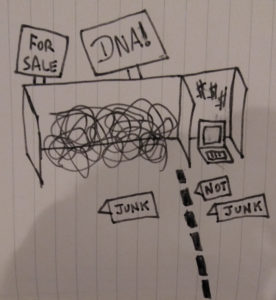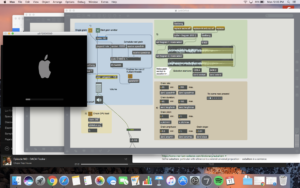To start off Temporary Expert, I pulled a random topic from the basket and got… Junk DNA!
I’m excited to be a four week expert on this. I’m segmenting this first blog post into two parts. My initial, uninformed ideas about junk DNA, and then my thoughts, feelings and followup after doing research.
At first, the thing that immediately draws me to the topic is the use of the word “junk”. Why is it junk? Says who? What are the motivations for such a categorization? I assume scientific, that this might be DNA that doesn’t “do” anything. But perhaps there are financial motivations for figuring out what certain things are caused by DNA, which could open up a possibility of critique.
My mind goes there because of “junk sales”, “junk bins” and so on. This term is evocative to me personal, as a somewhat hoarder, in the sense that I’m almost challenged to find something that I value inside of junk. “Junk” is almost a dare. Find something, it screams. The obscure piece of electronics. The dusty but solid piece of furniture. The cloth strips or old polaroids ripe for an art project.
And of course, ITP’s famous junk shelf comes to mind. I check it at least once a week (sometimes maybe two… three… ok, four times). It is junk, but is certainly useful to everyone on the floor at one point or another. With this in mind, I made this video:
This was made with my (not junk!) Macbook Pro and a quick Max MSP patch:
These are my initial, gut reactions to junk DNA. Was I right?
First, Junk DNA is known as a sub category within “noncoding DNA“. From the wiki, the key take aways are that noncoding DNA, “are components of an organism’s DNA that do not encode protein sequences,” and “When there is much non-coding DNA, a large proportion appears to have no biological function, as predicted in the 1960s. Since that time, this non-functional portion has controversially been called junk DNA.”
Oooh controversy! Lets look at the footnote for that.
ENCODE Project Writes Eulogy for Junk DNA
“In 2007, the pilot project’s results revealed that much of this DNA sequence was active in some way. The work called into serious question our gene-centric view of the genome, finding extensive RNA-generating activity beyond traditional gene boundaries.”
However, this article did not point me towards who even created the term “junk DNA” to begin with. Doing a quick search lead me to the charmingly old school “junkdna.com” (Marina, what was that about the internet being an unreliable appeal to authority?), and Dr. Susumu Ohno:
http://www.junkdna.com/ohno.html
https://en.wikipedia.org/wiki/Susumu_Ohno
And even though I thought that this topic might be a departure from more of my performance and sound based interests, I found this:
From the wiki:
“The biologist, with no formal training in music, ‘decided to assign notes according to the molecular weights’ and ‘put the heavier molecules in lower positions, and the lighter molecules higher’.”
This is an amazing bit of serendipity for me, as I have been interested in isomorphisms and event scores as a way to instigate creative inspiration and connection. The above paragraph reads to me like Fluxus in a lab coat, and I love it.
I didn’t expect to find this happening in the category of junk DNA. Not sure how much more I should indulge this specific aspect, but I’ll take it as a sign that I’ve got a great topic and the next few weeks will result in fruitful and inspiring research.
Components for understanding all of this will include understanding genomics, the differences between DNA vs. RNA, noncoding vs. coding vs. junk DNA, how gene/dna sequencing works, among many other things. (The more I read preliminarily, the more I uncover as necessary information. This list is expanding daily.)
Experts could include Dr.Ohno, the Encyclopedia of DNA Elements (ENCODE)(https://www.encodeproject.org), which is a project of the US National Human Genome Research Institute (NHGRI), and people who have challenged ENCODE’s work, like Dr.Dan Graur. His name came up in a few articles that I came across. (As one example; http://bigthink.com/paul-ratner/75-of-the-human-genome-is-junk-dna-claims-new-research)


awesome and wide ranging — great!
Junk is what we can things we don’t know what to do with (yet) – what are the historical antecedents – things people called wasteland (like wilderness)… tat is a paradigm problem, how we perceive, label, and categorize…
also, your list of junk sales made me think about how little i know about “junk bonds..”